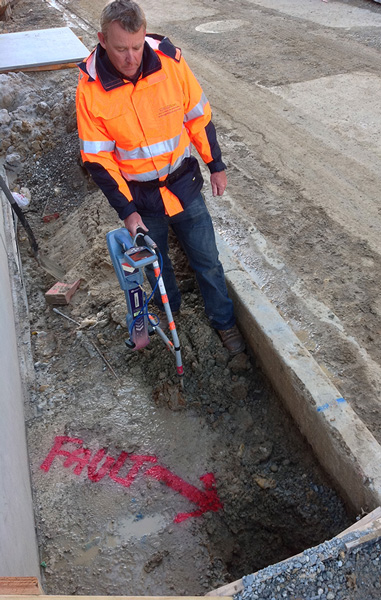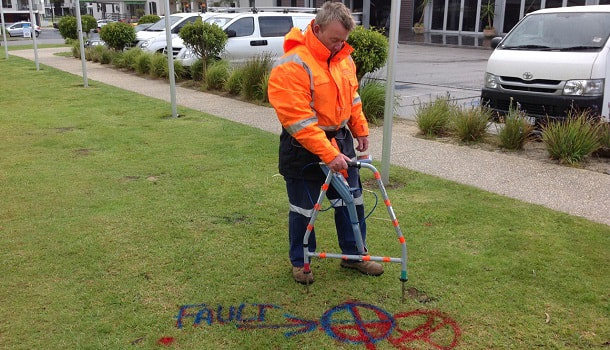While we are constantly building and remoulding properties, excavation is inevitable and can be undertaken for a variety of reason. What we are going to find out in this article is while performing an excavation, you must find out any underground running cables to avoid any casualties. Moreover, there can be cable faults lying down there just to create havoc.
A cable locator is basically an instrument which is deployed to detect presence of any such buried utility services well before performing any excavation activities. It also detects its location of such debris in any property. It is one important instrument because many fatalities can be prevented while excavation process. Who knows what all pipelines run underground! It can be water, gas, electricity or any other telecommunication lines.
It essentially has two parts- a transmitter and a receiver.
To determine such presence and locate its vicinity, a cable locator is used. Cable detection or fault finding can be done via two methods:
Passive Location:
Here, the electromagnetic field already present on the utility is detected with the help of a receiver or detector.
Active Location:
In this method, you inject a specific frequency signal with help of a transmitter and then race it back with a receiver.
To help you understand a bit more technically, let’s brush up some basics. When an alternating current is passed along any cable, which is generally done by the transmitter, then it naturally produces electromagnetic fields. Now, the current oscillates between the positive and negative (can you recollect the sine wave?) which creates a frequency which is termed as Hertz (Hz).
So, what does the cable locator do after all? Well, it detects that electromagnetic field generated while the current runs through the cable.
Now that you have a better idea about it,
Let’s look at the two methods in detail.
Passive Location Detection Method
 A utility might be carrying some signals which are radiated through a power cable. Otherwise, the radio signals that are emitted due to induced radiation on the utility can also be located. Depending upon the type of conductor, the transmitter’s electromagnetic field can be set.
A utility might be carrying some signals which are radiated through a power cable. Otherwise, the radio signals that are emitted due to induced radiation on the utility can also be located. Depending upon the type of conductor, the transmitter’s electromagnetic field can be set.
The three modes in which passive detection can be accomplished are:
- Power modeIt is simple that when an electromagnetic field is produced, its location can be detected via a receiver. So, when an AC current runs through any cable, it will inevitably generate electromagnetic field. Its location can be traced by using the cable locator. However, this is possible only in case of live current, while the current is passing through the cable. Thus, when there is no current flow, i.e. for instance the street lights are off, it cannot be detected if it is buried underground.
- Radio modeHere, there is a use of radio signals which are of low frequency and long wavelength. When such a radio signal is passed through the ground, it can also get into any type of metallic utilities. That signal will be re-emitted by them and thus, its location can be traced by keeping the locator in radio mode.
- Auto modeThe auto mode is combination of power and radio mode techniques. Both the methods are arrayed simultaneously. The best part is that this mode can confirm the presence of underground cables in the first site inspection itself.
Active Location
You might already be wondering about the how full-proof of the passive method. You guessed it right! Using just the passive mode, more than half such underground utilities can go undetected. And the site still is unsafe to be excavated.
Therefore, in active method, there is a signal cable locator and a signal transmitter. What is the difference? This unit will pass on a signal to the cable and that signal can be found by the cable locator.
This method can also be implemented using three techniques:
- Using an active signalSimply using the locator will make you miss out many buried cables because those are not carrying any current and nor do they emit any radio signals. In such a case, a signal is induced upon these buried utilities after which you can find them with the use of locator.
- Induction modeIn this method, you do not need to make any physical connection with the cables. A magnetic field is generated internally into the ground. If there is any metallic utility in its close proximity, then it will send signals which will be caught by the signal transmitter. And thus, the utility’s location can be found.
- Connection modeA signal is directly applied to the utility by connecting the signal transmitter output to the cable straightaway and forming a circuit by connecting to the ground connection point. Thus, the signal’s path can be easily traced. It is one of the most efficient methods.
- Locating the SignalThe signal can be located by detecting the magnetic field. In this method, wires are wrapped around ferrite rods and the locator uses that to find the electromagnetic signals. The small electromagnetic signals radiated by the utilities are amplified using these rods so that the locator’s circuit can get an input. A graphical display is produced showing the strength of the signal. The highest recording implies the locator is exactly below the utility.
These are some of the ways in which the cable locator works! The location of the cable, any fault in it can be found out and any possible accidents or injuries can be avoided.






